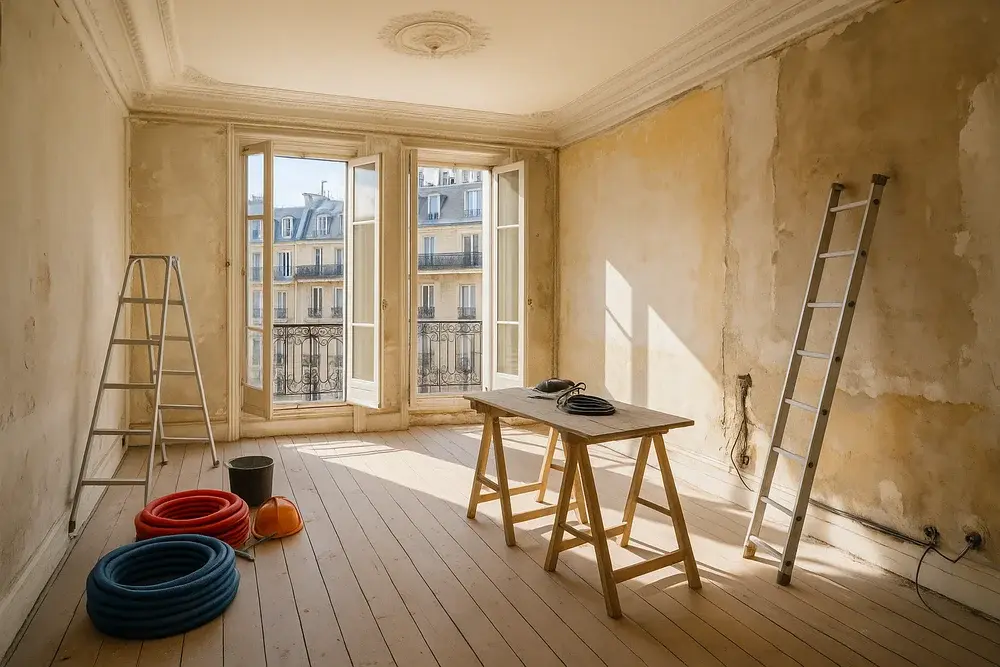Everything you need to know about new technologies in real estate 2.0
Imagine a home that can manage itself, anticipate your heating or security needs, and even warn you before equipment breaks down. Thanks to dramatic advances in new technologies, what once seemed like science fiction is now becoming a reality. One of these technologies, the Internet of Things (IoT), is already profoundly transforming the residential real estate sector by making homes smarter and more connected than ever.

Les new technologies play an increasingly crucial role in the residential real estate sector. Innovations such asArtificial intelligence (AI), 3D printing, and drones, are redefining not only how buildings are designed and built, but also how they are managed and experienced. THEThe impact of these technologies goes well beyond simple gains in efficiency or cost ; they are fundamentally changing our approach to housing, making it more sustainable, more secure and more adapted to modern needs.
In this article, we'll explore several breakthrough technologies that are shaping the future of residential real estate. We'll start by looking at innovations in building techniques, like the Building Information Modeling (BIM) And the3D printing. Next, we will discuss modern tools for management andreal estate maintenance, such as IoT and integrated management software.
We will also look at advancements improving the user experience, like the smart homes and virtual reality. Finally, we will discuss economic and environmental impacts of these technologies, highlighting their role in reducing costs and promoting sustainability.
Construction technologies

BIM (Building Information Modeling)
The Building Information Modeling (BIM) is a revolutionary method for modeling building information, allowing the creation of a detailed 3D digital model of each aspect of a real estate project. This technology integrates all relevant data, from architectural plans to technical details, thus facilitating collaboration between the various stakeholders.
Les main advantages of BIM lie in its ability to improve project planning and management. By centralizing information, it allows better coordination, reduces the risk of errors and delays, and optimizes theuse of resources.
3D printing
THE3D printing is another major innovation that is transforming the construction sector. This technique makes it possible to create structures by adding materials such as concrete, metal, or even bio-sourced composites layer by layer. Emblematic projects, such as 3D printed houses in China and the United States, demonstrate the potential of this technology to achieve rapid, economical and customizable constructions. THE3D printing significantly reduces material waste and makes it possible to produce complex shapes that are difficult to reach with.
{{cta-vert}}
Drones
Les Drones are becoming indispensable tools for topographic surveys and building inspections. Thanks to their flight capabilities and sophisticated sensors, they can capture accurate images and data, even in hard-to-reach areas. The use of drones improves survey accuracy, speeds up the inspection process, and reduces costs by minimizing the need for scaffolding or manual inspection techniques. By providing detailed aerial views, they allow construction professionals to better plan and monitor construction sites, thus ensuring more efficient and secure project management.
These construction technologies, whether it's BIM, 3D printing, or drones, are redefining industry standards. They offer innovative solutions to meet contemporary challenges, while paving the way for smarter, more sustainable and more economical buildings.
Management and maintenance technologies
IoT (Internet of Things)

The Internet of Things (IoT) is revolutionizing the management of infrastructures and equipment by integrating connected sensors into buildings. These sensors collect data on various parameters in real time such as temperature, humidity, energy consumption, and equipment condition.
For example, heating, ventilation and air conditioning (HVAC) systems can be monitored and adjusted automatically to optimize comfort and energy efficiency.
Practical examples include smart thermostats, water leak detectors, and automated lighting systems, all capable of communicating with each other to create a more responsive and efficient living environment.
Artificial intelligence and big data
THEArtificial intelligence (AI) and Big Data play a crucial role in predictive analytics for building maintenance and repairs. By exploiting the vast amounts of data collected by IoT systems, AI algorithms can identify patterns and anticipate equipment failures before they occur, allowing proactive interventions and reducing maintenance costs.
{{cta-bordeaux}}
In addition, these technologies optimize the use of energy resources by analyzing consumption data to propose energy-saving strategies, such as the automatic adjustment of heating and air conditioning systems according to theOccupation of spaces.
Real estate management software
Les real estate management software integrate various functionalities to simplify rental management and building maintenance. These solutions include modules for managing leases, tracking payments, scheduling maintenance, and communicating with tenants.
For example, platforms like Yardi or Propertyware offer user-friendly interfaces allowing property managers to centralize all current operations, thus reducing the time and effort required to administer the properties.
The advantages of these software are reflected in a simplifying processes, better organization of tasks, and an overall improvement in operational efficiency.
These management and maintenance technologies are transforming the real estate sector by introducing intelligent and interconnected systems. They allow for more proactive and effective management of infrastructures, while optimizing resources and improving the quality of life of residents.
User experience technologies

Smart Homes
Les smart homes integrate various technologies to improve the comfort and safety of residents. These technologies include automated lighting systems, security devices such as cameras and motion sensors, and smart heating systems.
For example, connected thermostats automatically adjust the temperature for optimal comfort, while lighting systems can be controlled remotely to create personalized environments. These innovations increase not only comfort but also safety, by allowing residents to monitor and control their homes from anywhere via mobile applications.
{{cta-vert}}
Virtual reality and augmented reality
La virtual reality (VR) And the Augmented reality (AR) transform the experience ofBuying real estate by allowing immersive virtual visits and the visualization of projects under construction. Prospective buyers can explore properties remotely, gain a realistic understanding of space and layouts, and even visualize potential changes.
For investors, these technologies offer a detailed view of ongoing projects, facilitating decision making. For example, an application of vr can simulate the interior layout of an apartment still under construction, allowing buyers to see what their future home will look like.
By integrating these technologies,Residential real estate is becoming more accessible and user-friendly. Smart homes, virtual and augmented reality, and mobile applications are revolutionizing the way people interact with their living spaces, improving their comfort, safety, and overall satisfaction.
Mobile applications and online platforms
It is an area where theuser experience could be greatly improved. Indeed, a buyer will be forced to navigate between multiple applications and online platforms in order to try to access the largest number of possible offers. Numerous attempts have been made by aggregators such as Jinka without being really convincing.
La Difficulty relates to the structuring of real estate agencies in France. Each has its own assets, do not share them with other agencies. Some properties are published on real estate advertising portals, others are not.
La plurality of means of distribution and the marketing of real estate in France makes it impossible (at least for the moment) for the buyer to find all real estate properties for sale on a single platform or mobile application.
{{cta-bordeaux}}
It is for this reason that in large French cities where real estate markets are generally tense, the service offer of real estate hunters is relevant. They offer to take charge of the search for apartments, houses or lofts for buyers who have little time to devote or who are not present.
Economic and environmental impacts

Cost reduction
Les new technologies in residential real estate allow substantial savings thanks to theautomation and optimization of processes. The use ofInternet of Things (IoT) And of theArtificial intelligence (AI) in building management reduces operational costs by improving energy efficiency and by anticipating maintenance needs.
For example, the IoT sensors can detect equipment problems before they become costly failures, while AI can optimize heating and cooling systems to reduce power consumption. These innovations also make it possible to reduce construction and maintenance costs, positively impacting sale and rental prices. The savings can be reinvested in additional improvements or passed on to consumers in the form of more attractive prices.
Sustainability and eco-design
Les modern technologies play a crucial role in promoting the sustainability and eco-design in real estate. Innovations such as green building materials, energy management systems, and advanced building techniques, such as 3D printing, contribute to reducing the carbon footprint of buildings.
For example, the bio-sourced and recycled materials used in construction reduce the environmental impact, while intelligent energy management systems reduce consumption and greenhouse gas emissions.
Technologies such as integrated solar panels And the rainwater harvesting systems make buildings more autonomous and ecologically responsible. These initiatives not only protect the environment, but they also respond to growing consumer demand for greener and sustainable homes.
{{cta-vert}}
By integrating these technologies,residential real estate becomes not only more economical but also more environmentally friendly. La reduction in operational costs And theimproving environmental sustainability create a virtuous circle, where financial and ecological benefits reinforce each other, thus ensuring a more sustainable and profitable future for the real estate sector.
Conclusion on new technologies in real estate
Summary of key points
Over the course of this article, we explored how new technologies are transforming residential real estate. We have seen how Building Information Modeling (BIM), 3D printing and drones are revolutionizing construction techniques. For management and maintenance, technologies such as the Internet of Things (IoT), Artificial Intelligence (AI) and software of property management optimize operations and reduce costs.
When it comes to user experience, smart homes, virtual and augmented reality enhance comfort, safety and conviviality. Finally, we discussed economic and environmental impacts, highlighting the savings made and sustainable initiatives promoting ecological constructions.
Future perspective
Les Expected developments in the residential real estate sector are promising. With the acceleration of technological innovations, we can anticipate an even deeper integration of connected and intelligent systems in buildings. Les advancements in AI and big data will allow for even more accurate analyses and more effective predictive maintenance. In addition, the continued focus on sustainably will encourage the adoption of materials and construction techniques that are even more environmentally friendly. Les Houses of the future will not only be smart and efficient, but also designed to minimize their ecological impact.
{{cta-bordeaux}}
Call to action
It is crucial for real estate professionals, builders, and property managers to adopt these technologies now to stay competitive and meet growing consumer expectations in terms of efficiency and sustainability. Integrating these innovations into current and future projects will not only optimize costs and processes, but also create safer habitats, more comfortable and more environmentally friendly.
Together we can building a smarter and sustainable real estate future. Let's adopt these technologies to improve the quality of life for all and protect our planet for future generations.
Learn more :




